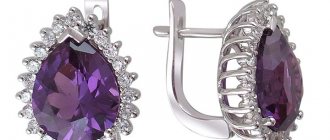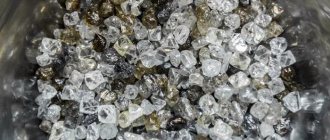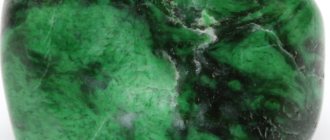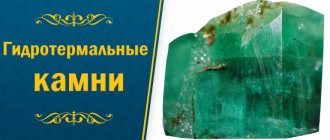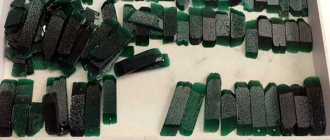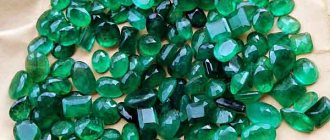What is emerald
Emerald is a first category gemstone, which is a transparent variety of beryl. The gem has a crystalline structure, the highest quality specimens have high transparency, dichromism (the ability to change one shade of color to another). Most emeralds are dark and pale green, sometimes there are specimens with a yellowish or bluish tint.
In terms of its value, the mineral is comparable to sapphire, diamond and ruby. The price of the stone depends on the degree of transparency, uniformity and color saturation, the presence of defects - bubbles, microcracks, inclusions.
Mining emeralds
People have been mining emeralds since ancient times. Depending on geological conditions, there are deposits in nature:
- pegmatite – igneous vein rocks;
- pneumatolytic – minerals formed by hot vapors and gases;
- placer types of deposits - accumulation of clastic rocks.
Depending on the type of formation, there are several ways to extract the gemstone.
Extraction methods
If the emerald deposit is located close to the surface of the earth, the gems are mined by open-pit mining:
- to find stones, a quarry is dug out manually or with a bulldozer, and the top layers of soil are cut off;
- When a precious mineral is discovered, large pieces of rock are brought to the surface of the earth and gems are extracted from them.
Often, years of open-pit mining turn out to be fruitless - emeralds suitable for processing are not found in the rocks.
In addition to the open method, emeralds are mined using the shaft method. It implies large scale production and labor automation. In small mines they use simple tools and low-power explosives. In large mines, special conditions are maintained: good ventilation, pumping out water, and a temperature of 15 degrees.
Production stages
In the mines where emeralds are mined, the work process is divided into several important stages:
- First, the rock is studied visually. When green crystals are found on the surface, they are removed manually using special devices.
- Then, a cavity is punched in the rock into which explosives are placed. For these purposes, gentle explosives are used to minimize the breaking of precious stones.
- Rock fragments formed after the explosion are loaded into a trolley and sent to the surface of the earth.
- The raw materials are dried within 48 hours, after which they are sent to a gemologist for sorting.
- The gemologist responsible for processing raw materials saws and crushes gems in the direction of cracks and chips.
- The minerals, separated into fractions, go to an automated sink, where clay, layers of dirt and dust are washed off.
- At the last stage, the resulting stones are sorted again, selecting valuable images of “jewelry quality”. After sorting precious stones, some waste unsuitable for jewelry remains.
With good primary processing of emerald raw materials, in the hands of a jeweler the stones take the given shape and are cut. If sorted and cut poorly, during the cutting process, emeralds show numerous defects: cracks, chips, inclusions.
History of the Ural spring
The country and the world first heard about Malyshevsky minerals from the light hand of smolokur Kozhevnikov. In 1831, he discovered several green stones in the roots of a tree protruding from the ground. Thus, an emerald vein was discovered, which managed to provide the country with colossal income.
The Ural spring turned out to be more than generous. In the first ten years after the start of emerald mining, more than 5 thousand carats of stones were cut. Thirty years later it was already 142 pounds of minerals.
In the 30s the situation changed. The governing bodies of the USSR relied not on gems, but on beryllium ore deposits. They supplied dozens of large enterprises in the defense industry. The mining of precious stones has practically disappeared. The rock was mercilessly blown up with dynamite, all in order to get to rare tantalum and beryllium.
Despite a significant decrease in turnover in mineral mining, the USSR even then maintained the level of ten percent of world stone production. Ural emeralds were considered one of the best in the world and brought significant income to the country.
The finds in the Malyshevsky mine were amazing. Some stones had such fantastic parameters that the best mineralogical museums in the world would gladly compete for them. Each such gem was processed and given a name.
In 1993, on the basis of the main Ural mine, two autonomous
The initial prospects for their appearance seemed rosy and promising. But the prosperity of an behind-the-scenes organized crime group disrupted the course of the alleged events. The gems were extracted by handicraft methods and sold in the criminal world, providing the authorities with a stable income.
We predict the result. JSC “Emerald Mines of the Urals” did not stay afloat for even three years. The situation of the bankrupt company could not be saved even thanks to a unique find - a gem weighing 1.2 kilograms, which received the name “President”. The stone, discovered in the mine in 1993, was seized due to non-payment of wages to miners.
Today, the largest stone in history is preserved in the Diamond Fund. It was sold for ridiculous money - only 150 thousand dollars, while the real price was tens of times higher.
In 1999, JSC “Emerald Mines of the Urals” together with the Irish. The budget of the new organization included $12 million for reconstruction work with the subsequent placement of shares of the storage facility on the market. In 2008, the company was deprived of its license due to failure to comply with a number of conditions specified in it.
After the government order for the extraction of beryllium concentrate was lifted, several foreign companies took over the spring, but were unable to put it into operation and led to almost complete flooding.
Emerald deposits
Today, only a few countries can boast of large deposits of high-quality emerald. Green gems are mined in small quantities in more than 30 countries around the world.
Africa
Africa ranks second in the world in terms of production of green gems. Emerald deposits were discovered here relatively recently - at the beginning of the 20th century. Today, operating African mines are located in Tanzania, Zimbabwe, and Zambia. Stones mined on the continent are of high quality, rich blue-green color and small in size.
Brazil
Brazil is the world's leading supplier of emeralds. Their main deposits are located in the east of the country, in Bahia and Minais Gerais. But Brazilian gems are not of first-class quality; they are colored rich green with a yellowish tint.
Interestingly, emerald mining in Brazil is mainly carried out by freelance miners. They extract the mineral mainly by open-pit mining, since they do not have the money to develop a mine or purchase expensive equipment.
India
In India, emeralds are mined using open pit and underground mining methods. The largest deposits of the precious mineral are located in Rajasthan and near the city of Ajmir. In most small deposits, workers work on the surface.
Colombia
More than half of the world's emerald production comes from Colombia. High quality gems are found here, distinguished by their large sizes and pure, rich color. Most of the country's mines are located in the Eastern Cordillera. Often, mines are attacked, resulting in crystals ending up in smuggled markets.
Russia
Domestic emerald mines are located in the Urals. Russian gems are distinguished by their high density and large size. The Russian Federation competes with Colombia in the quality and richness of the color of stones. But there are not as many Ural gems as Colombian ones.
HISTORICAL EXCURSION
Previously, green stones were called “emeralds”.
- The first ancient deposits of emeralds were located on the Arabian Peninsula and in Egypt, where Cleopatra’s mines were mined long before our era.
- The Aswan mines are also famous: mining work took place there during the time of the pharaohs more than 3,000 years ago. Green minerals were mined in mines whose depth reached 200 meters. It was believed that the gem did not tolerate light, so workers worked at night.
- In Colombia in the 16th century. The conquistadors provoked emerald fever. Having invaded the territory where the Indians lived, the Spaniards discovered high-grade emeralds there.
- In the 19th century, Yakov Kovkin discovered Ural emeralds. Later, 15 tons of minerals were mined near Yekaterinburg.
- In Soviet times, all mining was concentrated on beryllium, necessary for industrial use. At the same time, green gems were mined along the way.
Cost of emeralds
The price of an emerald depends on its quality: purity and color saturation, size, cut shape, presence or absence of defects. Depending on this, the cost of different specimens ranges from 18,000 to 600,000 Russian rubles per carat.
In the jewelry market, counterfeits - chrome diopsides - are often passed off as real stones. They have a visual resemblance to emerald, but most methods of jewelry cutting are not applicable to them.
Decorations
Jewelry with emeralds is always in sight, they look rich and attract the attention of others. Jewelers often combine green gems with sapphires and diamonds in expensive jewelry. For the setting of stones, yellow, red and pink gold, silver, and platinum are used.
Bracelets, pendants, large earrings and necklaces with emeralds are more suitable for special occasions rather than for everyday wear. More discreet options - elegant emerald rings or earrings without unnecessary details, will successfully complement a business suit or office look.
Interesting Facts
- Colombian guajeros are free emerald miners who mine the gems on their own. Today, almost all deposits have been sold to foreign investors. When unsorted stone is thrown from deposits, people try to take the pieces, even leading to violence.
- People working in the Colombian mines undergo a week-long training course and use only the simplest, cheap tools, which is why their lives are always at risk. Their working day is 12 hours, and their pay is usually limited to a bowl of stew. At the same time, workers are given a lot of local alcoholic drink - guarapo.
- Muzo, a region of the country where rich mines are located, is almost completely controlled by paramilitary groups.
- It is believed that the Indian Sultan Shah Jahan, on whose orders the famous Taj Mahal was built, wore a gem with sacred texts engraved on it. Hence the origin of the legend that the gem is a stone of love - after all, the palace built by the Sultan is considered a symbol of high feelings.
- The largest specimen was brought from Brazil, its weight is 28 kg.
- The emerald deposit near Aswan has long been considered a fiction. However, in 1818 it was reopened.
Mining emerald is important for people, because it is not only beautiful, but also has many useful qualities. This stone is widespread on the planet, so we can hope that natural emerald will be used more often than synthetic ones for a long time. Read more about hydrothermal emerald →
How to distinguish real from fake?
Semi-precious varieties of beryl, non-precious minerals and artificial crystals are often passed off as emeralds. You can distinguish a natural stone from a fake by the following characteristics:
- Emerald crystals resemble pieces of green velvet. Too pronounced shine and sparkling transparency are more characteristic of glass that imitates a natural gem.
- It is also worth focusing on the cost of the precious mineral. There are no large transparent stones at an attractive price; they cost a fortune.
- The presence of a yellow or blue tint, slight cloudiness, the presence of small cracks or inclusions indicates the average quality of the green gem, but guarantees that the stone is natural.
Products with real emeralds do not tolerate chemicals and are resistant to prolonged exposure to bright sunlight.
Magic properties
The main task of the emerald is to fight the bad inclinations of its owner: deceit, a tendency to scam, infidelity in love.
If the owner of the stone does not have bad inclinations, the emerald brings him health and good luck, otherwise it can send disasters to the person.
This gem is able to dispel any negative energy, cleanse a person’s biofield and his home from negativity. Emerald protects the family hearth: it preserves marital ties, maintains peace and harmony in the family, and promotes procreation.
This stone helps people with developed intuition to get into contact with the souls of the dead, with creatures from the subtle world, and gives the ability to decipher signals sent to Earth by the forces of the Universe. Emerald is a very delicate stone. He does not tolerate aggression and rudeness. If you wear the stone constantly for 2-3 months, a person can correct these negative character traits.
Astrologers claim that the gem helps nervous, sensitive people avoid stress and expose deceptions and intrigues. It is very suitable for Leo, Libra and Aquarius. Emerald is strictly contraindicated for Pisces, Capricorns and Scorpios. Other signs can wear it.


